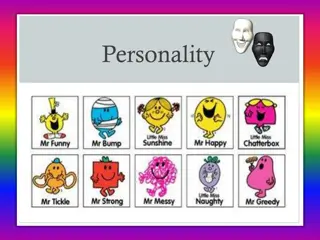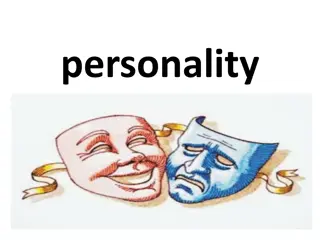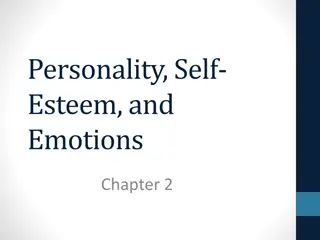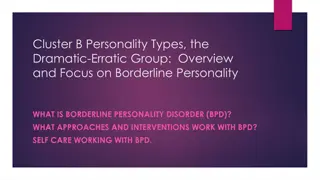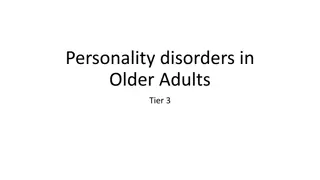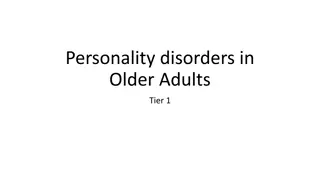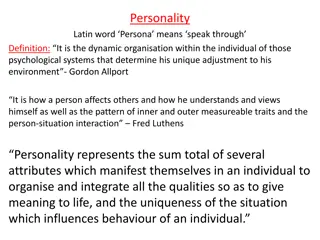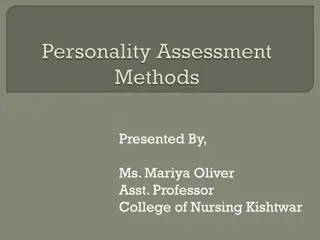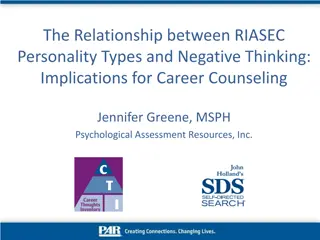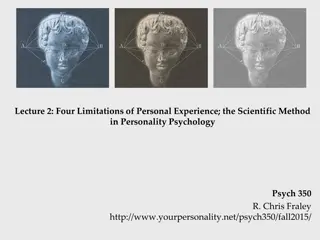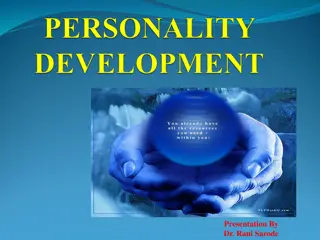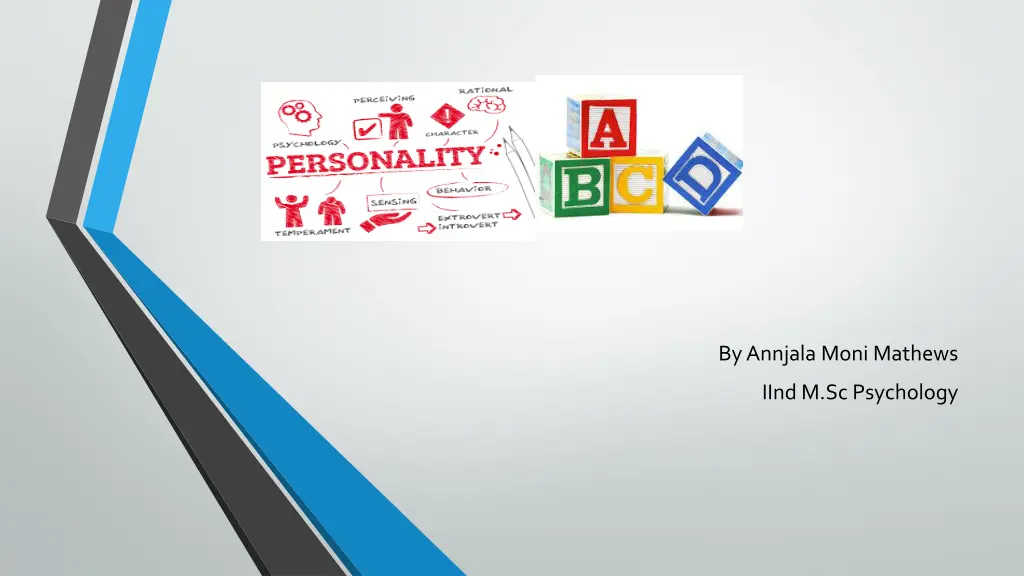
Understanding Personality Types and Traits
Discover the dynamic nature of personality through Type A and Type B personalities. Type A individuals are goal-oriented and prefer control, while Type B individuals are outgoing and seek approval from others. Explore the strengths, weaknesses, motivations, and potential career paths associated with each type.
Download Presentation

Please find below an Image/Link to download the presentation.
The content on the website is provided AS IS for your information and personal use only. It may not be sold, licensed, or shared on other websites without obtaining consent from the author. If you encounter any issues during the download, it is possible that the publisher has removed the file from their server.
You are allowed to download the files provided on this website for personal or commercial use, subject to the condition that they are used lawfully. All files are the property of their respective owners.
The content on the website is provided AS IS for your information and personal use only. It may not be sold, licensed, or shared on other websites without obtaining consent from the author.
E N D
Presentation Transcript
By Annjala Moni Mathews IIndM.Sc Psychology
Personality is the dynamic organization within the individual of those psychophysical systems that determine his characteristics behavior and thought" (Allport, 1961, p. 28). The characteristics or blend of characteristics that make a person unique (Weinberg & Gould, 1999).
Type A personality likes to be in charge and be in control of their environment and their lives. They re usually very goal-oriented and practical in their solutions. They prefer to work all alone by themselves and does not like any restrictions.
MOTIVATIO N FOR TYPE A Money Opportunity Freedom/ind ependence Favorable risk-reward ratio Challenges Urgency Success Leadership STRENGTHS OF TYPE A Embraces change Fast-paced Entrepreneurial Direct management style Ambitious Works well independently Dominant Good administrative skills Highly competitive WEAKNESS OF TYPE A Stubborn Workaholic Impatient Abrupt Tough Easily angered
President/CEO General contractor Salesperson or sales manager Business owner Politician Entrepreneur Police/military officer Manager Executive
Those with type B personality are very outgoing, energetic, and fast-paced individual who likes to be around people and enjoys being the center of attention. Their driving force is approval from other s for which they work hard to make other s accept them.
Strengths of Type B Enthusiasm Fun-loving Persuasiveness Easily liked by most people Friendliness Charismatic People-oriented People-oriented Weakness of Type B Too self-involved May try to do too much at once Impatient Sometimes unrealistic Trouble being alone Motivation for Type B Public recognition Awards, plaques, certificates Having picture taken with celebrities Acceptance
Public relations Salesperson Entertainment Personnel interviewer Politician
A person with Type C personality are very detail-oriented individual who likes to be involved in things that are controlled and stable. Their main interest will be for accuracy, rationality and logic.
Strengths of Type C Accuracy Creative Dependable Imaginative Independent Detailed Organized Intelligent Analytical Critical thinker Weakness of Type C Worry about progress Critical behavior Likes to do things their own way Motivation of Type C Control Opportunities to be independent and analytical Challenges Problem-solving
Engineer Technical support Research scientist Game designer Data analyst Pilot Inventor
It is usually seen that type D personality usually seen to take a slower, easier pace towards the work that they are assigned of and even about their life. They get a security in the work that they are repeting and doesn t like if the rules changes since they don t want to change.
Strength of Type D Caring Sincere Compassionate Stable Fair and equitable Calm Reliable Consistent Weakness Not speaking up Easily used by others Uncomfortable with constant change Resistant to change Motivation Stability Benefits Security Low risk Routine Team/group opportunities Calm work atmosphere
Secure team position Administrator Financial services HR manager Social worker Family doctor/nurse Mechanic Teacher
Gordon Allport (1897 1967) was a well-respected and influential American scholar in the psychology field.According to Allport, the personality traits are influenced by our childhood experiences, our current environment, and the interaction between them. He put forward three trait which are as follows: Secondary traits- They re only seen in certain situations or under specific circumstances. For example, a person whose cardinal trait is assertiveness may show signs of submission when the police stops them for speeding. This is just a situational trait that may or may not show up during other interpersonal encounters. Cardinal traits- Some historical figures with strong cardinal traits are Abraham Lincoln for his honesty, Marques de Sade for his sadism, and Joan of Arc for her heroic self-service. People with such personalities are known for these traits and their names are often associated with these qualities.Allport suggested that cardinal traits are rare and tend to develop over the years. Central traits- Central traits are the general characteristics that form the basic foundations of personality.It seen that each person has between 5 and 10 central traits. They re present to varying degrees in each person.These include common traits such as intelligence, shyness, and honesty.
Eysenck believed personality is largely governed by biology, and he viewed people as having two specific personality dimensions: extroversion vs. introversion and neuroticism vs. stability. Later collaborating with his wife and fellow personality theorist Sybil Eysenck, he added a third dimension to this model: psychoticism vs. socialization. In the neuroticism/stability dimension, people high on neuroticism tend to be anxious; they tend to have an overactive sympathetic nervous system and even with low stress, their bodies and emotional state tend to go into a flight-or-fight reaction. In contrast, people high on stability tend to need more stimulation to activate their flight-or-fight reaction and are therefore considered more emotionally stable. In the psychoticism/socialization dimension, people who are high on psychoticism tend to be independent thinkers, cold, nonconformist, impulsive, antisocial, and hostile. People who are high on socialization tend to have high impulse control they are more altruistic, empathetic, cooperative, and conventional. According to their theory, people high on the trait of extroversion are sociable and outgoing and readily connect with others, whereas people high on the trait of introversion have a higher need to be alone, engage in solitary behaviors, and limit their interactions with others.
Jungs 8 Personality Types Jung formulated eight personality types, which are the basis for the Briggs Myers 16 personality. The eight types are: Extraverted Thinking Introverted Thinking Extraverted Feeling Introverted Feeling Extraverted Sensation Introverted Sensation Extraverted Intuition Introverted Intuition
Hippocrates theorized that personality traits and human behaviors are based on four separate temperaments associated with four fluids ( humors ) of the body: choleric temperament (yellow bile from the liver), melancholic temperament (black bile from the kidneys), sanguine temperament (red blood from the heart), and phlegmatic temperament (white phlegm from the lungs). Years later, the influential Greek physician and philosopher Galen built on Hippocrates s theory, suggesting that both diseases and personality differences could be explained by imbalances in the humors and that each person exhibits one of the four temperaments. For example, the choleric person is passionate, ambitious, and bold; the melancholic person is reserved, anxious, and unhappy; the sanguine person is joyful, eager, and optimistic; and the phlegmatic person is calm, reliable, and thoughtful.


